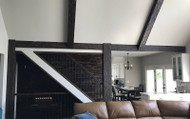
Why Are Fake Wood Beams Better Than The “Real” Thing?
Fake wood beams are a great way to add to the overall look and feel of a room, but some homeowners may wonder whether faux wood is truly better than the real deal.
While real wood does have its own appeal, fake wood has many advantages that are often too good to pass up. When making the choice between the two, in most cases, faux wood is the optimal choice.
4 Reasons Fake Wood Beams Are Better Than Real Wood Beams
There are several reasons why fake wood beams are better, and we’ll discuss those reasons in detail below.
1. Aesthetic Quality
One of the concerns you may have about fake wood is whether it holds up visually. And, you’ll be pleased to know that you can find fake wood beams that look exactly like the real thing.
Most faux wood products are made from high-density polyurethane, a material which allows for highly realistic textures. In many cases, it’s impossible to tell the difference between fake wood beams and real beams simply by looking at them.
Since fake wood beams are molded from real wooden beams, there is a great deal of flexibility when it comes to the color and texture you want. And, the price for any look remains fairly consistent, whether you are looking for an old timber oak or hand hewn mahogany.
The possibilities are limitless, enabling you to choose just the right color and texture for your home.
2. Lightweight Composition
In addition to the wide range of visual qualities available, fake wood is also far lighter than real beams. Polyurethane foam weighs only a fraction of real wood, and fake wood beams are hollowed out on the inside, further cutting weight down and allowing room for cables or pipes, if needed.
Although fake wood beams aren’t good for structural framing, their lightweight composition does offer a multitude of advantages, including ease of installation. It takes far less work and fewer resources to install fake wood beams than it does to install real wood.
Genuine timber requires a great deal of manpower, expertise, and equipment to install, and special care needs to be taken to make sure it doesn’t put too much strain on the home’s structure.
Safety is also an issue—if a real beam falls, the risk of injury is very real.
Fake wood beams, on the other hand, can be easily installed as a DIY project. Each beam can be carried by one person, and you don’t need any special hardware to fix them in place. Installing fake wood beams on your ceiling is a simple two-person job rather than a lengthy high-cost project.
3. Lower Maintenance
Along with the ease of installation, polyurethane adds enduring beauty to your home in that it doesn’t decay the way real wood does.
Real beams may rot over time, losing the initial aesthetic beauty they would add to your home, and they can also be eaten away by pests. Polyurethane doesn’t have this problem—it endures for decades to come without the risk of rot or infestation.
Fake wood beams don’t decay over time, ultimately being far easier to maintain. Real wood needs to be treated, and repairs can be costly. However, if your fake wood beams get nicked or damaged, they can be quickly fixed with some caulk or glue. Their lightweight renders them simple to take down and reinstall as needed when repairs become necessary.
Polyurethane is also weatherproof, often more so than real wood, making it a great complement to outdoor areas without the need for high maintenance.
4. Cost Effectiveness
Their lightweight, ease of installation, and low maintenance make fake wood beams more cost effective than real wood. In addition, faux wood frequently costs less upfront than real wood, lowering their impact on your finances.
The lightweight composition of fake wood beams means they’re easy to install, but also easy to transport. This equates to lower shipping costs and further savings.
Meanwhile, they’ll last for decades without the need for expensive maintenance or restorations.
One more cost advantage comes from the fact that fake wood beams are hollow. If you need to run wiring, it’s easier to hide in a fake wood beam than to try embedding it in the walls or ceiling. Home functionality is much less costly.
Experience The Benefits Of Fake Wood Beams
Ultimately, fake wood beams provide all the aesthetic benefits of real wood without the drawbacks, so it’s a great option to improve the level of sophistication in a space.
Whether you intend to use them to bring dimension to your kitchen or add texture to your living room, fake wood is the way to go for any home improvement project.